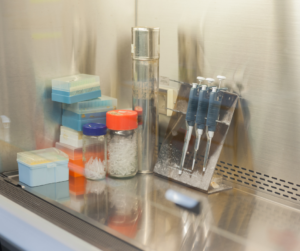The primary function of a fume hood is to protect laboratory personnel. A chemical fume hood, often referred to as simply a fume hood, is designed to move air containing harmful vapors away from the operator. With a ducted fume hood, the air containing harmful vapors or aerosols is continuously moved away from the laboratory employee and pushed through the building’s exhaust system and then into the air outside. But what happens when the building is not equipped with the ducting and venting needed for a traditional fume hood? Is a ductless fume hood the better choice? With the safety of your lab personnel at stake, you’ll want to carefully weigh your options before making a decision.
What is a Ductless Fume Hood?
Ductless fume hoods are also known as exhaust hoods, filtered fume hoods, and recirculating fume enclosures. These hoods are stand-alone pieces of laboratory equipment that are lightweight and furnished with filters that capture hazardous fumes and particles. They are often used when portability is needed and the lab where they are used handles only a limited amount of chemicals. Ductless fume hoods are equipped with a carbon filter system that filters and recirculates clean air back into the laboratory work area. Some of the benefits of using filtered fume hoods are that they are easy to install, require minimal maintenance, offer mobility, and use less energy than their ducted counterparts.
How Do Ductless Fume Hoods Work?
Ductless fume hoods are equipped with a fan to pull in contaminants. Once the air is drawn in, it moves through a filter called the pre-filter. The pre-filter starts the process of capturing particles that are emitted by the chemicals used within the hood. After passing through the pre-filter, the air continues onto the main filter. This filter captures smaller particles and odors that were not contained by the pre-filter. After the air is filtered for the second time, it is released back into the work area. Because the air is recirculated within the laboratory, no exterior ductwork is necessary.
Is a Ductless Fume Hood the Right Choice for my Lab?
While we have covered some of the benefits of ductless fume hoods, it is important to know they are not the proper choice for every lab. Some of the downfalls of these hoods include:
- Noise from the fan
- Filter costs
- Higher risk of chemical exposure
- Handles only a limited number of chemicals
- Not designed for continuous use
- Not as reliable as ducted fume hoods
There are additional questions that should also be addressed before deciding if your lab will better benefit from a ductless or ducted fume hood.
If you need assistance in choosing the right fume hood or cabinet for your work area, please don’t hesitate to contact us. At Fisher American, we have a remarkable selection of casework, workstations, fume hoods, and related lab products. Most of our items can be shipped quickly. In most cases, less than two weeks.
Related Content



